The Caribbean Island of Grenada
|
|
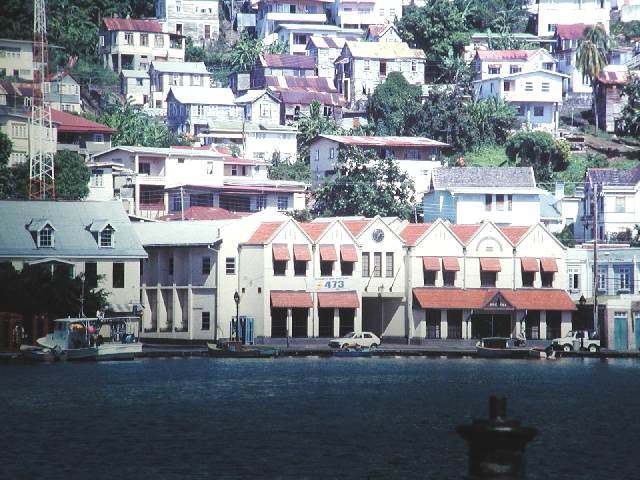 Grenada is an island nation and
sovereign state consisting of the island of Grenada and six smaller islands at the southern
end of the Grenadines in the southeastern Caribbean Sea. Grenada is located northwest of
Trinidad and Tobago, northeast of Venezuela, and southwest of Saint Vincent and the
Grenadines. Its size is 344 km² with an estimated population of 110,000. Its capital is St.
George's. The national bird of Grenada is the critically endangered Grenada Dove. Grenada is an island nation and
sovereign state consisting of the island of Grenada and six smaller islands at the southern
end of the Grenadines in the southeastern Caribbean Sea. Grenada is located northwest of
Trinidad and Tobago, northeast of Venezuela, and southwest of Saint Vincent and the
Grenadines. Its size is 344 km² with an estimated population of 110,000. Its capital is St.
George's. The national bird of Grenada is the critically endangered Grenada Dove.
History
The recorded history of Grenada begins in 1498. At the time the indigenous Island Caribs (Kalinago)
who lived there called it Camahogne. The Spaniards did not permanently settle on Camahogne. Later
the English failed their first settlement attempts, but the French fought and conquered Grenada
from the Caribs circa 1650. The French conquest resulted in the genocide of 17th century Caribs
from present-day Grenada. Warfare also existed between the Caribs of present day Dominica and St.
Vincent and the Grenadines with the French invaders. The French took control of Camahogne and named
the new French colony La Grenade. La Grenade prospered as a wealthy French colony; its main export
was sugar. The French established a capital known as Fort Royal in 1650 as ordered by Cardinal
Richelieu. To wait out harsh hurricanes, the French navy would shelter in the capital's natural
harbor. No other French colony had a natural harbour to even compare with that of Fort Royal (later
renamed St. George's). The colony was ceded to the United Kingdom in 1763 by the Treaty of Paris. A
century later, in 1877 Grenada was made a Crown Colony
|
Grenada Geography
|
|
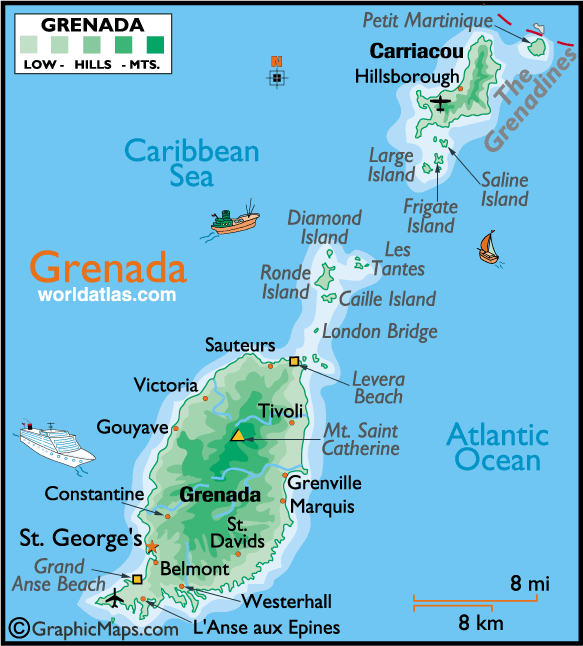
On his third voyage to the New World in 1498, Columbus sailed by Grenada and named it
Concepcion. The British attempted a small settlement in 1609, but it was the French that
successfully battled the cannibalistic Carib Indians, finally driving them off the island in
1651.
Military and political struggles continued on the islands for two centuries, with Grenada
finally becoming an independent country in 1974.
Then, in 1983, Grenada was seized by a Marxist military group. This action facilitated an invasion
by US forces and those of six other Caribbean nations; they captured the ringleaders and hundreds
of Cuban advisers and free elections were reinstituted the following year.
Grenada (the country) includes the large island of Grenada, and a few islands on the southern
edge of the Grenadines, with Carriacou and Petit Martinique the most significant.
Volcanic in origin, Grenada is dominated by a central ridge of mountains, all covered with lush
rainforests. The island is blessed with numerous bays and harbors, and some of the best beaches in
the Caribbean.
Once famed only for its indigenous spices (namely mace and nutmeg), Grenada's modern focus is
tourism, and the islands are deservedly garnering the attention of the travel industry.
|
|
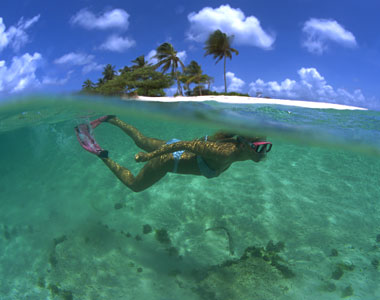
The island Grenada itself is the largest island; smaller Grenadines are Carriacou, Petit
Martinique, Ronde Island, Caille Island, Diamond Island, Large Island, Saline Island and Frigate
Island. Most of the population lives on Grenada itself, and major towns there include the capital,
St. George’s, Grenville and Gouyave. The largest settlement on the other islands is Hillsborough on
Carriacou.
The islands are of volcanic origin with extremely rich soil. Grenada’s interior is very
mountainous with Mount St. Catherine being the highest at 2,756 feet (840 m). Several small rivers
with beautiful waterfalls flow into the sea from these mountains. The climate is tropical: hot and
humid in the rainy season and cooled by the trade winds in the dry season. Grenada, being on the
Southern edge of the hurricane belt, has suffered only three hurricanes in fifty years.
Hurricane Janet passed over Grenada on 23 September 1955 with winds of 115 mph, causing severe
damage. The most recent storms to hit have been Hurricane Ivan on September 7, 2004 causing severe
damage and thirty-nine deaths and Hurricane Emily on July 14, 2005, causing serious damage in
Carriacou and in the north of Grenada which had been relatively lightly affected by Hurricane
Ivan.
|
Economy and Tourism
Economic progress in fiscal reforms and prudent macroeconomic management have
boosted annual growth to 5%–6% in 1998–99; the increase in economic activity has been led by
construction and trade. Tourist facilities are being expanded; tourism is the leading foreign
exchange earner. Major short-term concerns are the rising fiscal deficit and the deterioration in
the external account balance. Grenada shares a common central bank and a common currency (the East
Caribbean dollar) with seven other members of the Organization of Eastern Caribbean States
(OECS)
Grenada is called The Spice Isle because it is a leading producer of several
different spices. Cinnamon, cloves, ginger, mace, allspice, orange/citrus peels, wild coffee used
by the locals, and especially nutmeg, providing 20% of the world supply, are all important exports.
The nutmeg on the nation's flag represents the economic crop of Grenada; the nation is the world’s
second largest producer of nutmeg (after Indonesia).
|
Grenada Flag
|
|

The flag of Grenada features the usual Pan-African colors of red, Gold and green
since, the country has an African origin. The flag was given official status in 1974. Although the
civil ensign and the national flag of Grenada are different, yet, they are only marginally so
differing only in the color ratio. The naval ensign of Grenada portrays the British white ensign
but with the national flag being featured on the cross.
On the Pan African color background are
portrayed 7 stars which are a representation of the 7 parishes in this small Caribbean island. One
of the stars, the central one is portrayed specially with a red disk surrounding it and this star
is a dedication to Saint George after whom the capital of Grenada has been named. The flag also
gives due importance to the name of “Spice Island” that Grenada is popularly referred to as. On the
flag's left-hand corner is portrayed a clove of nutmeg which incidentally is also Grenada's
principal crop.
|
Tourism is Grenada’s
|
main economic force. Conventional beach and water-sports tourism is largely focused in the
southwest region around St Georges, the airport and the coastal strip; however, ecotourism is
growing in significance. Most of these small ecofriendly guesthouses are located in the Saint David
and Saint John parishes. The tourism industry is increasing dramatically with the construction of a
large cruise ship pier and esplanade. Up to 4 cruise ships per day were visiting St. Georges in
2007–8 during the cruise ship season.
The island has also pioneered the cultivation of organic cocoa which is also processed into
finished bars by the Grenada Chocolate Company.
Tourism is concentrated in the southwest of the island, around St. Georges, Grand
Anse, Lance Aux Epines, and Point Salines. Grenada has many idyllic beaches around its coastline
including the 3 km long Grand Anse Beach in St George's which is considered to be one of the finest
beaches in the world, and often appears in countdowns of the worlds top 10 beaches.
Grenada is linked to the world through the Point Salines International Airport and the St. George’s
harbour. International flights connect with other Caribbean islands, the United States, and Europe.
There is also a daily fast ferry service between St. George’s and Hillsborough.
Demographics
A majority of the citizens
are descendants of the African slaves brought by the Europeans; few of the indigenous Carib and
Arawak population survived the French purge at Sauteurs. A small percentage of descendants of East
Indian indentured workers were brought to Grenada mainly from the North Indian states of Bihar and
Uttar Pradesh between May 1, 1857–January 10, 1885. There is also a small community of French and
English descendants. The rest of the population is of mixed descent.
Grenada, like many of the Caribbean islands is subject to a large amount of migration, with a
large number of young people wanting to leave the island to seek life elsewhere. With just 110,000
people living in Grenada, estimates and census data suggest that there are at least that number of
Grenadian-born people in other parts of the Caribbean (such as Barbados and Trinidad) and at least
that number again in First World countries. Popular migration points for Grenadians further north
include New York City, Toronto, the United Kingdom (London and Yorkshire predominantly — see
Grenadians in the UK) and sometimes Montreal, or as far south as Australia. This means that
probably around a third of those born in Grenada still live there.
The official language, English, is used in the government, but Grenadian Creole is considered
the lingua franca of the island. French Patois (Antillean Creole) is still spoken by about 10%–20%
the population. Some Hindi/Bhojpuri terms are still spoken amongst the Indian descendants, mostly
those pertaining to the kitchen; such as aloo, geera, karela, seim, chownkay, and baylay. The term
bhai, which means 'brother' or 'partner' in Hindi, is a common form of greeting amongst
Indo-Grenadians males of equal status.
Aside from a marginal community of Rastafarians living in Grenada, nearly all are mainstream
Christians, about half of them Roman Catholics; Anglicanism is the largest Protestant denomination
with Presbyterian and Seventh Day Adventist taking up the remainder. Most Churches have
denomination-based schools but are open to all. There is a small Muslim population mostly from
Gujarati Indian immigrants who came many years ago and set up some merchant shops.
|
| Back to the Top | Return Home | Grenada
Directory | Caribbean Hotels | Grenada Hotels |
Grenada’s Culture
|
|
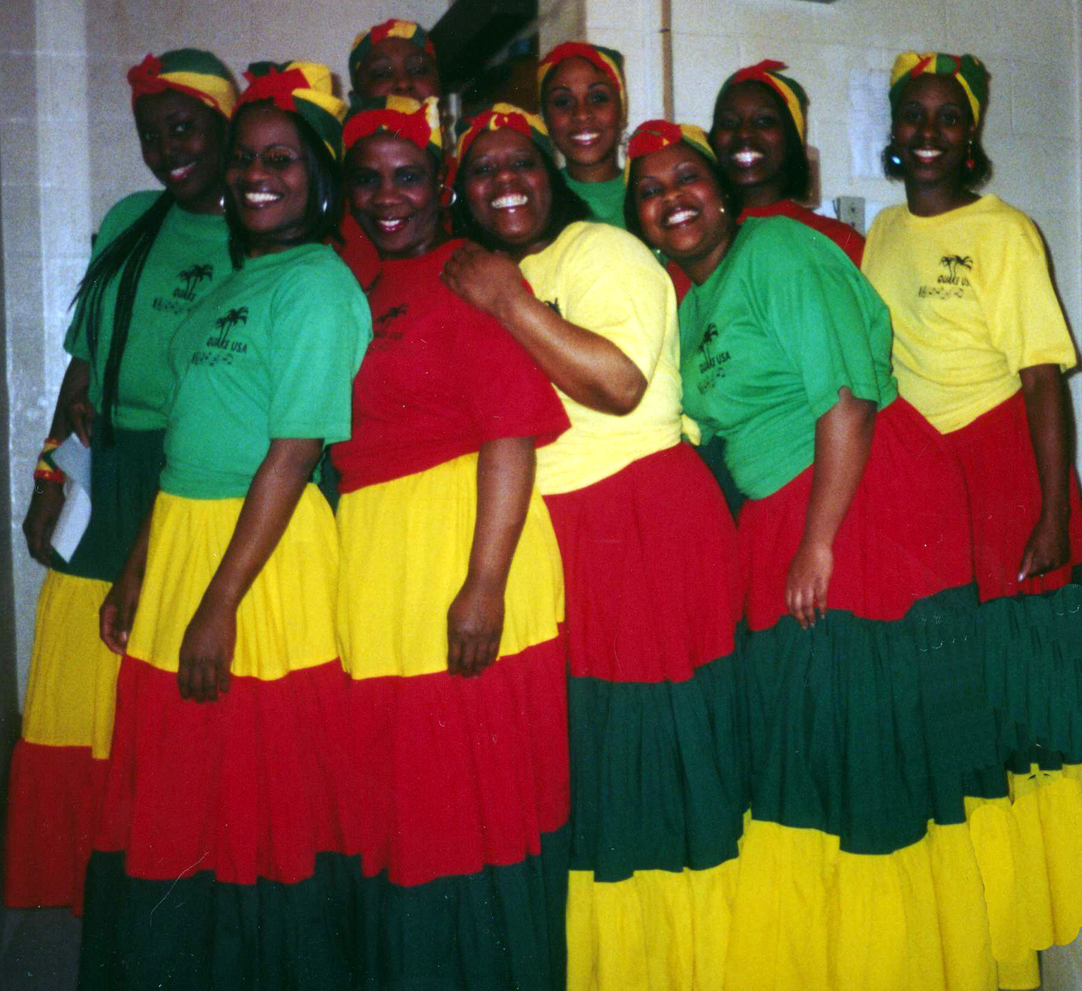
Although French influence on Grenadian culture is much less visible than on other Caribbean
islands, surnames and place names in French remain, and the every day language is laced with French
words and the local dialect or Patois. Stronger French influence is found in the well seasoned
spicy food and styles of cooking similar to those found in New Orleans and some French architecture
has survived from the 1700s. Island culture is heavily influenced by the African roots of most of
the Grenadians but Indian influence is also seen with dhal puri, rotis, Indian sweets, and curries
in the cuisine.
The "oildown" is considered to be the national dish. The phrase "oil-down" refers to a dish
cooked in coconut milk until all the milk is absorbed, leaving a bit of coconut oil in the bottom
of the pot. Early recipes call for a mixture of salted pigtail, pigs feet (trotters), salt beef and
chicken, dumplings made from flour, provision: breadfruit, green banana, yam and potatoes. Callaloo
leaves are some times used to retain the steam and for extra flavour.
This dish is a common tradition at family and other gatherings at the beach, There is a modest
debate in the West Indies about the origin of this dish, with some experts attributing it to other
islands like Barbados or Trinidad & Tobago.[citation needed]
Foods aren’t the only important aspect of Grenadian culture. Music, dance, and festivals are also
extremely important. Soca, calypso, and reggae set the mood for Grenada's annual Carnival
activities. Zouk is also being slowly introduced onto the island. The islanders’ African heritage
plays an influential role in many aspects of Grenada’s culture.
As with other islands from the Caribbean, cricket is the national and most popular sport and is an
intrinsic part of Grenadian culture.
An important aspect of Grenadian culture is the tradition of story telling, with folk tales bearing
both African and French influences. The character, Anancy, a spider god who is a trickster,
originated in West Africa and is prevalent on other Caribbean islands as well. French influence can
be seen in La Diablesse, a well-dressed she-devil, and Ligaroo (from Loup Garoux), a
werewolf.
|
|
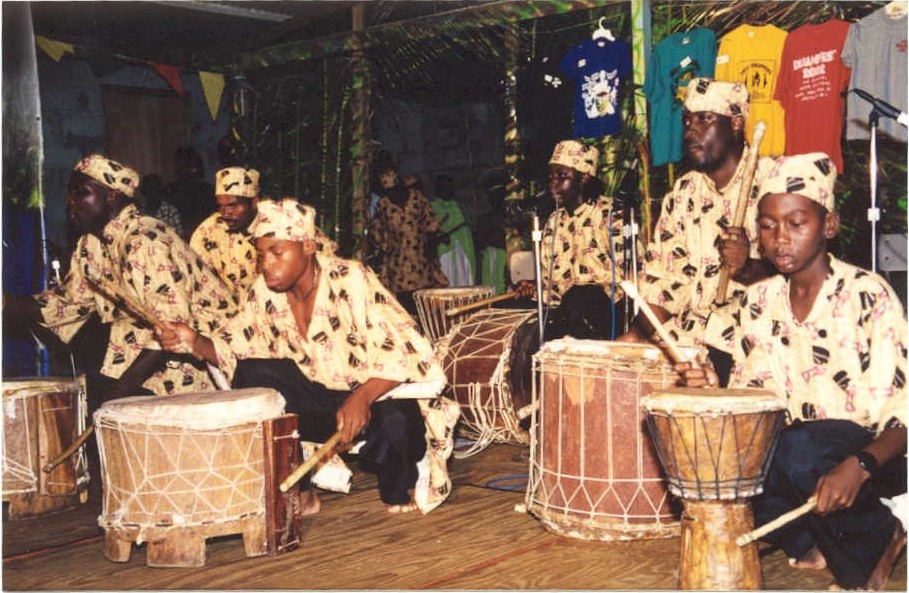
Music in Grenada
Grenada is a small Caribbean island nation that has produced several major musicians, including
David Emmanuel, one of the best-selling reggae performers ever, and Mighty Sparrow, a legendary
calypsonian. The island is also known for jazz, most notably including Kingsley Etienne, a
keyboardist, while the Grenadan-American Joe Country & the Islanders have made a name in
country music.
African dances brought to Grenada survive in an evolved form, as have European quadrilles and
picquets. Some of the most popular recent dances include Heel-and-Toe and Carriacou Big Drum, with
popular dancers including Willie Redhead, Thelma Phillips, Renalph Gebon and the Beewee Ballet.
Independence in 1974 launched a Grenadian national identity which was exemplified in the calypso
of the time, which tended to be intensely patriotic. More modern calypso performers have
experimented, using political commentary and poetry to expand the possibilities of Grenadian
calypso. Indian influences have also changed the sound of Grenadian calypso.
Shopping in Grenada
Grenada offers a colorful palette of Souvenirs, wood carvings and paintings, ranging from naive to
sophisticated, jewelry , from natural materials to Emeralds and Gold. Batiks in the fabulous colors
of the Caribbean and of course Spices, Jams, Jellies and our Plantation Rum's.
Shopping Malls: most of Grenada (big) shopping centres are located in the Grand Anse area, but
you will also find a huge variety of souvenirs shops and art galleries in town (St.George's). Not
to be forgotten, our vendor market directly on the Grand Anse beach.
Our general business hours are from Monday - Friday| 8 am - 4 pm and Saturdays from 8 am - noon.
But most of our big Supermarkets are open until 7 pm, the Real Value Supermarket in the Spiceland
Mall (Grand Anse) until 9 pm weekdays and also open on Sunday until 4 pm.
|
Things to do in Grenada
|
|
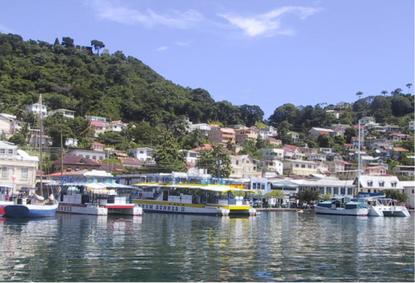 Be sure to check to all these items in your
list if you want to say back home that you visited Grenada: Be sure to check to all these items in your
list if you want to say back home that you visited Grenada:
1) Walk in St.George, Grenada's beautiful capital; visit St. George's Roman Catholic Church, York
House (the site of the House of Representatives), the Senate and the Supreme Court;
2) Walk along the wharf road by the harbor and have a look at the luxurious ships and modest
fishing boats arriving and departing from the Carenage;
3) Visit Market Square on Saturday morning and buy spices;
4) Walk along the Esplanade in the evening and admire the dramatic sunset; 5) Visit Fort George and
admire the wonderful sight of the harbor;
6) Visit Grenville and take a tour to the see the processing of nutmeg, Grenada's most valued
spice;
7) Visit River Antoine Rum Distillery, learn the traditional methods of rum preparation;
8) Admire Mt. Rich Ameriandian petroglyphs;
9) Visit Levera National Park and snorkel in the waters to admire the coral reefs and sea grass
beds; and
10) Go to the beach, spend hours swimming and enjoying the sight of the turquoise sea.
|
Getting married in Grenada
|
|

Couples must be resident in Grenada for 3 working days in advance of their
wedding.
Application for a Marriage Licence should be made in person at the Prime Minister's Office after
the necessary stamp duty and licence fees have been paid at the Treasury office. This process takes
approximately two days (and slightly longer if either partner is divorced, as documents must then
be sent to The Ministry of Legal Affairs).
Documents required
* Valid Passports
* Birth Certificates
* If one of the parties is divorced, proof of a Decree Absolute
* Proof of Single Status: an affadavit, or a letter from a clergyman, lawyer, or Registry on
official letterhead attesting to the fact that the parties involved have not been married
previously.
* If a name has been changed by Deed Poll proof is necessary
* If either party has been widowed, a Death Certificate is needed
* If either party is under 21 evidence of parental consent is required in the form of an
affadavit
* All papers must be in English. If the original papers are in another language, they should be
translated into English and certified
* No blood tests are required
Fees
Marriage Licence: EC$10
Stamp: EC$15
Registration Search: EC$2
Stamp: EC$5
Registrars Offices
The registrar's office should be contacted for specific rules regarding planning your
destination or beach wedding in Grenada. They will also provide information regarding marriage
licenses and marriage certificates.
Prime Ministers Office
6th Floor | Ministerial Complex | Botanical Gardens | St George's | Grenada | Tel: 473 443 4688
Registry General's Office
Ground Floor, Ministerial Complex,
Botanical Gardens | St George's | Grenada | Tel: 473 330 2649
|
Our source: Over 70% of the information on this page was taken from
http://wikitravel.org the other information was from knowledge of the island
and http://www.mapsofworldcom ' http://www.islandbrides.com
|
 Grenada is an island nation and
sovereign state consisting of the island of Grenada and six smaller islands at the southern
end of the Grenadines in the southeastern Caribbean Sea. Grenada is located northwest of
Trinidad and Tobago, northeast of Venezuela, and southwest of Saint Vincent and the
Grenadines. Its size is 344 km² with an estimated population of 110,000. Its capital is St.
George's. The national bird of Grenada is the critically endangered Grenada Dove.
Grenada is an island nation and
sovereign state consisting of the island of Grenada and six smaller islands at the southern
end of the Grenadines in the southeastern Caribbean Sea. Grenada is located northwest of
Trinidad and Tobago, northeast of Venezuela, and southwest of Saint Vincent and the
Grenadines. Its size is 344 km² with an estimated population of 110,000. Its capital is St.
George's. The national bird of Grenada is the critically endangered Grenada Dove.




 Be sure to check to all these items in your
list if you want to say back home that you visited Grenada:
Be sure to check to all these items in your
list if you want to say back home that you visited Grenada:
